Study on Safety Tunneling Technology of Secondary Outburst Elimination by CO2 Gas Fracturing in High-Outburst Coal Seam
Abstract
:1. Introduction
2. Research Background
2.1. Engineering Background
2.2. Coal Mine Gas Geological Properties
3. Methods
3.1. Evaluation of Gas Outburst Prevention Measures
3.2. Experiment of the CO2-Frac for Outburst Prevention and Safe Excavation
3.2.1. CO2-Frac: Its Principles, Key Technical Parameters, and Experiment Scheme
3.2.2. Evaluation of the Effectiveness of Eliminating Outbursts with K1 Value
- (1)
- After the CO2-Frac is completed in the 2 boreholes, 18 shallow boreholes, with 75 mm bits and a depth of 16 m, shall be drilled on the working face to release gas for a period of 8–24 h (Figure 5);
- (2)
- Then, drill 9 holes with a depth of 10 m and 42 mm bits in the working face, as shown in Figure 5. The regulations require a K1 test from only 3 holes in which 1 is drilled in front and 2 in the two walls. The 9 holes are designed here by the safety management for evaluating the serious outburst-prone coal covering a large area;
- (3)
- Each borehole starts from the depth of 3 m of the hole, and a coal cutting sample is taken every 1 m or 2 m to measure the gas desorption index K1 of the drill cuttings; Require each drill hole to be taken the sample depth is staggered, that is, if the first borehole sampling hole depth is 3 m, 4 m, 6 m, 8 m, 10 m, the second borehole should be 3 m, 5 m, 7 m, 9 m, 10 m, the third borehole sampling hole is the same depth as the first borehole;
- (4)
- Take 10 g of 1–3 mm coal cuttings screened for a gas desorption index K1 test in a test equipment GDT following the Standard of AQ/T 1065-2008 [42];
- (5)
- A total of 45 K1 values were obtained from the 45 cutting samples of 9 holes;
- (6)
- When K1 < 0.5 from all the 45 tests, this indicates there is no outburst risk in the sampling and testing area, and excavation ahead of 7 m is allowed;
- (7)
- If there is 1 sample with K1 ≥ 0.5 from the 45 tests, this indicates an outburst risk existing in the area. Thus, continue to drill 18 shallow boreholes to release gas on the working face for the next round of K1 test and evaluation, until K1 < 0.5, which then allows for 7 m excavation ahead.
4. Results Analysis and Discussions
4.1. Outburst Risk Evaluation with K1 Value after CO2-Frac
4.2. Analyzing the Monthly Roadway Excavation
4.3. Mechanism of Outburst Elimination and K1 Value Reduction by CO2-Frac
5. Conclusions
- (1)
- Dual-bole and high-pressure CO2-Frac can promote the rapid release of gas, homogenize and rapidly reduce the gas pressure and gas content through intensive and uniform fracturing and a wide range of pressure relieving, so as to fully eliminate the outburst risks of tectonic coal zones that are prone to outburst, and it can effectively solve the problem of the mining–excavation connection;
- (2)
- After implementing high-pressure CO2-Frac, K1 exceedances per hundred meters of tunnel excavations decreased from an average of 2.54 without CO2-Frac to an average of 0.28 with CO2-Frac, an eight-fold decrease. The monthly excavation speed also increased from 81.64 m without CO2-Frac to 162.42 m with CO2-Frac, a two-fold increase;
- (3)
- On-site industrial tests have proven that high-pressure CO2-Frac, as an economical and efficient secondary outburst prevention technology, can effectively solve the problem of uneven and insufficient initial outburst prevention under complex gas-geological conditions. As an effective safety measure for secondary outburst prevention in coal tunnels, it is worth learning from and promoting coal tunnel excavation of severely protruding coal seams with similar gas-geological conditions.
Author Contributions
Funding
Data Availability Statement
Acknowledgments
Conflicts of Interest
References
- Li, J. The State Bureau of Mine Safety Supervision on Notice on Strengthening the Prevention and Control of Coal and Gas Outburst. Available online: https://www.chinamine-safety.gov.cn/zfxxgk/fdzdgknr/tzgg/202204/t20220415_411767.shtml (accessed on 19 July 2023).
- Lin, B. China’s High-Quality Economic Growth in the Process of Carbon Neutrality. China Financ. Econ. Rev. 2022, 11, 3–22. [Google Scholar] [CrossRef]
- Yuan, L. Challenges of countermeasures for high quality development of China’s coal industry. China Coal 2020, 46, 6–12. [Google Scholar] [CrossRef]
- Xie, H.; Ren, S.; Xie, Y. Development opportunities of the coal industry towards the goal of carbon neutrality. J. China Coal Soc. 2021, 46, 2197–2211. [Google Scholar] [CrossRef]
- Hodot, B.B. Coal and Gas Outbursts; Song, S.Z.; Wang, Y.A., Translators; China Industry Press: Beijing, China, 1966. [Google Scholar]
- Zheng, Z.M. Understanding the Mechanism of Coal and Gas Outbursts through Order of Magnitude and Dimensional Analysis. In Collected Works of Zheng Zhemin; Science Press: Beijing, China, 2004. [Google Scholar]
- Xu, T.; Tang, C.A.; Song, L. Numerical Simulation of Coupled Gas Flow in Failure Process of Gassy Coal-Rock. Chin. J. Rock Mech. Eng. 2005, 24, 1667–1673. [Google Scholar]
- Yang, W.; Lu, C.Z. Tunnelling outburst potential affected by mechanical properties of coal seam. Tunn. Undergr. Space Technol. 2019, 83, 99–112. [Google Scholar] [CrossRef]
- Zhao, Y.; Lin, B.Q.; Liu, T. Mechanism of multifield coupling-induced outburst in mining-disturbed coal seam. Fuel 2020, 272, 117716. [Google Scholar] [CrossRef]
- Yang, Y.L.; Han, P.H.; Zhao, Z.N.; Chen, W. The Method of Determining Layer in Bottom Drainage Roadway Taking Account of the Influence of Drilling Angle on Gas Extraction Effect. Sustainability 2022, 14, 5449. [Google Scholar] [CrossRef]
- Wang, H.F.; Cheng, Y.P.; Wang, L. Regional gas drainage techniques in Chinese coal mines. Int. J. Min. Sci. Technol. 2012, 22, 873–878. [Google Scholar] [CrossRef]
- Xie, S.; Yang, B.; Zhang, Q.; Song, H. Research on lift pressure system with combined pipeline and intensive drill-hole gas drainage along the layer in low permeability coal seam. J. Min. Sci. Technol. 2019, 4, 34–40. [Google Scholar] [CrossRef]
- Mou, P.W.; Pan, J.N.; Wang, K.; Wei, J.; Yang, Y.; Wang, X. Influences of hydraulic fracturing on microfractures of high-rank coal under different in-situ stress conditions. Fuel 2021, 287, 119566. [Google Scholar] [CrossRef]
- Dontsov, E.V. Morphology of multiple constant height hydraulic fractures versus propagation regime. Int. J. Numer. Anal. Methods Geomech. 2022, 46, 1177–1183. [Google Scholar] [CrossRef]
- Cheng, Y.; Lu, Y.; Ge, Z.; Cheng, L.; Zheng, J.; Zhang, W. Experimental study on crack propagation control and mechanism analysis of directional hydraulic fracturing. Fuel 2018, 218, 316–324. [Google Scholar] [CrossRef]
- Min, R.; Chen, X.J.; Wang, L.; Huang, Z.; Li, H.T. Study and application of reasonable parameters for hydraulic punching of layer penetration boreholes in Changping Coal Mine. Energy Sci. Eng. 2023, 11, 3020–3032. [Google Scholar] [CrossRef]
- Kalore, S.A.; Sivakumar Babu, G.L. Hydraulic conductivity requirement of granular and geotextile filter for internally stable soils. Geotext. Geomembr. 2022, 50, 510–520. [Google Scholar] [CrossRef]
- Wen, H.; Mi, W.S.; Fan, S.X.; Liu, M.Y.; Cheng, X.J.; Wang, H. Determining the reasonable volume required to inject liquid CO2 into a single hole and displace CH4 within the coal seam in bedding boreholes: Case study of SangShuPing coal mine. Energy 2023, 266, 126522. [Google Scholar] [CrossRef]
- Mi, W.; Wen, H.; Fan, S.; Wei, G.; Liu, M.; Wang, S.; He, H.; Wu, X.; Cheng, X.; Liu, B.; et al. Pilot test of high-pressure water jet slotting with liquid CO2 injection to displace CH4 and improve coal seam permeability. Fuel 2023, 351, 128822. [Google Scholar] [CrossRef]
- Zou, Q.; Liu, H.; Cheng, Z.; Zhang, T.; Lin, B. Effect of Slot Inclination Angle and Borehole-Slot Ratio on Mechanical Property of Pre-cracked Coal: Implications for ECBM Recovery Using Hydraulic Slotting. Nat. Resour. Res. 2020, 29, 1705–1729. [Google Scholar] [CrossRef]
- Zou, Q.; Liu, H.; Jiang, Z.; Wu, X. Gas flow laws in coal subjected to hydraulic slotting and a prediction model for its permeability-enhancing effect. Energy Sources Part A Recovery Util. Environ. Eff. 2021, 1–15. [Google Scholar] [CrossRef]
- Xiao, W.; Li, K.; Zhu, C.; Li, Z.; Lin, B.; Ma, C.; Si, M. Numerical Investigation on Potential Influencing Factors Affecting Drainage Effective Radius of Crossing Borehole. Sustainability 2023, 15, 2485. [Google Scholar] [CrossRef]
- Li, Y.; Zhai, C.; Ding, X. Technology and application of dynamic pressure gas secondary drainage through borehole in bottom drainage roadway of high gas outburst coal seam. Saf. Coal Mines 2022, 53, 191–196. [Google Scholar] [CrossRef]
- Cheng, Z. Study on optimization of strata passing borehole sealing depth and borehole layout space in floor gas drainage gateway. Coal Sci. Technol. 2017, 45, 76–82. [Google Scholar] [CrossRef]
- Henan Energy Chemical Group Co., Ltd. Hebi Coal and Electricity Company Sixth Coal Mine ‘6.4’ Large Coal and Gas Outburst Accident Case. China Coal News. 2022. Available online: https://www.chinamine-safety.gov.cn/zfxxgk/fdzdgknr/sgcc/sgalks/202202/t20220221_408254.shtml (accessed on 21 February 2022).
- Cao, Y.; Zhang, J.; Zhang, X.; Liu, S.; Elsworth, D. Micro-fractures in coal induced by high pressure CO2 gas fracturing. Fuel 2022, 311, 122148. [Google Scholar] [CrossRef]
- Zhang, J.F.; Cheng, S.F.; Gao, Z. Practice and simulation of coal-rock mining by liquid carbon dioxide blasting. Coal Sci. Technol. 2020, 48 (Suppl. S1), 24–27. [Google Scholar]
- Hu, G.Z.; He, W.R.; S, M. Enhancing coal seam gas using liquid CO2 phase-transition blasting with cross-measure borehole. J. Nat. Gas Sci. Eng. 2018, 60, 164–173. [Google Scholar] [CrossRef]
- Sun, K.M.; Xin, L.W.; Wu, D. Simulation of fracture law of supercritical CO2 explosive under initial stress condition. J. Vib. Shock 2018, 37, 232–238. [Google Scholar]
- Chen, H.D.; Wang, Z.F.; Chen, X. Increasing permeability of coal seams using the phase energy of liquid carbon dioxide. J. CO2 Util. 2017, 19, 112–119. [Google Scholar] [CrossRef]
- Cao, Y.; Zhang, J.; Zhai, H.; Fu, G.; Tian, L.; Liu, S. CO2 gas fracturing: A novel reservoir stimulation technology in low permeability gassy coal seams. Fuel 2017, 203, 197–207. [Google Scholar] [CrossRef]
- Cao, Y.; Zhang, J.; Tian, L.; Zhai, H.; Fu, G. Research and application of CO2 gas fracturing for gas control in low permeability coal seams. J. China Coal Soc. 2017, 42, 2631–2641. [Google Scholar] [CrossRef]
- National Mine Safety Administration. Provisions on Prevention and Control of Coal and Gas Outbursts; China Coal Industry Publishing House: Beijing, China, 2019.
- Coal Information Research Institute. Prevention of Coal and Gas Outburst Rules and Prevention of Coal and Gas Outburst Provisions; China Coal Industry Publishing House: Beijing, China, 2019. [Google Scholar]
- Cheng, Y.; Zhou, H. Research progress of sensitive index and critical values for coal and gas outburst prediction. Coal Sci. Technol. 2021, 49, 146–154. [Google Scholar] [CrossRef]
- Cao, Y.; Peng, L.; Hou, Q. Basic characteristics of coal seam faults and their geological significance. Geol. Rev. 1993, 39, 522–528. [Google Scholar]
- Cao, Y.; Peng, L. Basic type of coal seam faults and their effect on controlling gas outburst zone. J. China Coal Soc. 1995, 20, 413–417. [Google Scholar]
- Cao, Y.; Zhang, H.; Zhang, Z.; Liu, G. Characteristics of coal and gas outburst and controlling mechanism of stress field in the hanging wall of normal faults. Coal Geol. Explor. 2022, 50, 61–69. [Google Scholar] [CrossRef]
- Zhang, F. Research into the Mechanism and Application of Liquid CO2 Phase-Transition Fracturing in a Coal Seam to Enhance Permeability. Sustainability 2023, 15, 3308. [Google Scholar] [CrossRef]
- Shang, Z.; Wang, H.; Li, B.; Cheng, Y.; Zhang, X.; Wang, Z.; Geng, S.; Wang, Z.; Chen, P.; Lv, P.; et al. The effect of leakage characteristics of liquid CO2 phase transition on fracturing coal seam: Applications for enhancing coalbed methane recovery. Fuel 2022, 308, 122044. [Google Scholar] [CrossRef]
- Xu, M.F. Research of Liquid CO2 Phase Transition Fracturing Technology Radius in Coal Seam. Master’s Thesis, Henan Polytechnic University, Jiaozuo, China, 2016. [Google Scholar]
- AQ/T 1065-2008; Determination Method of Gas Desorption Index by Drill Cuttings. Chongqing Research Institute of Coal Science Research Institute: Chongqing, China, 2008.
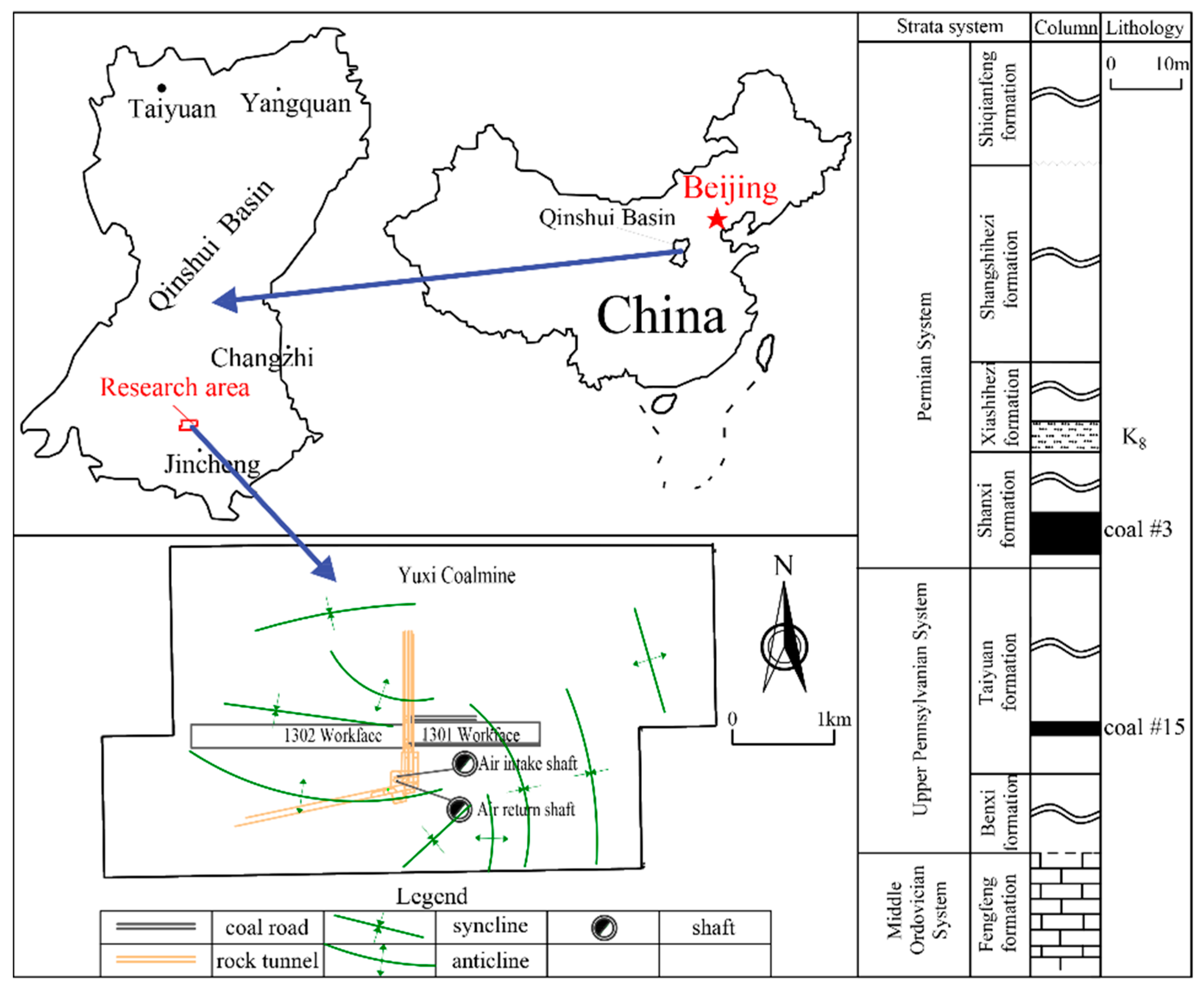
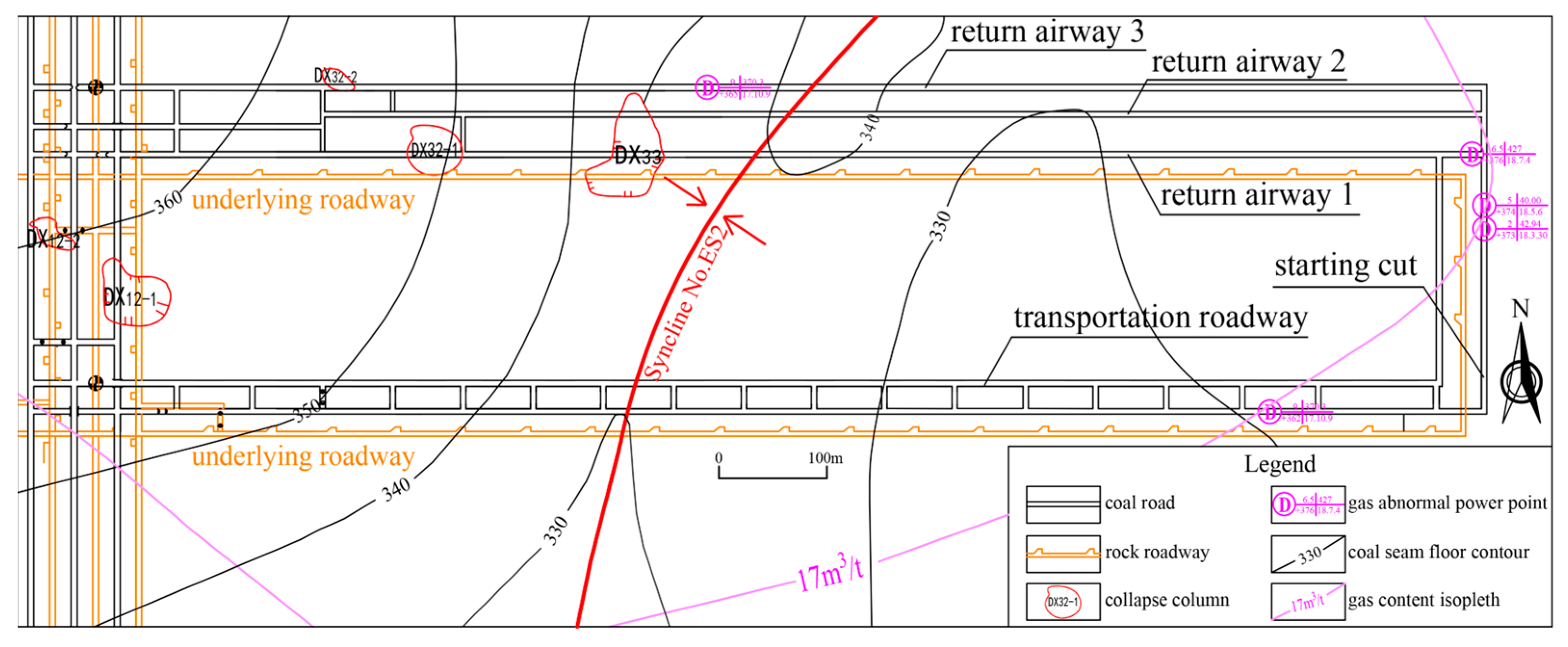
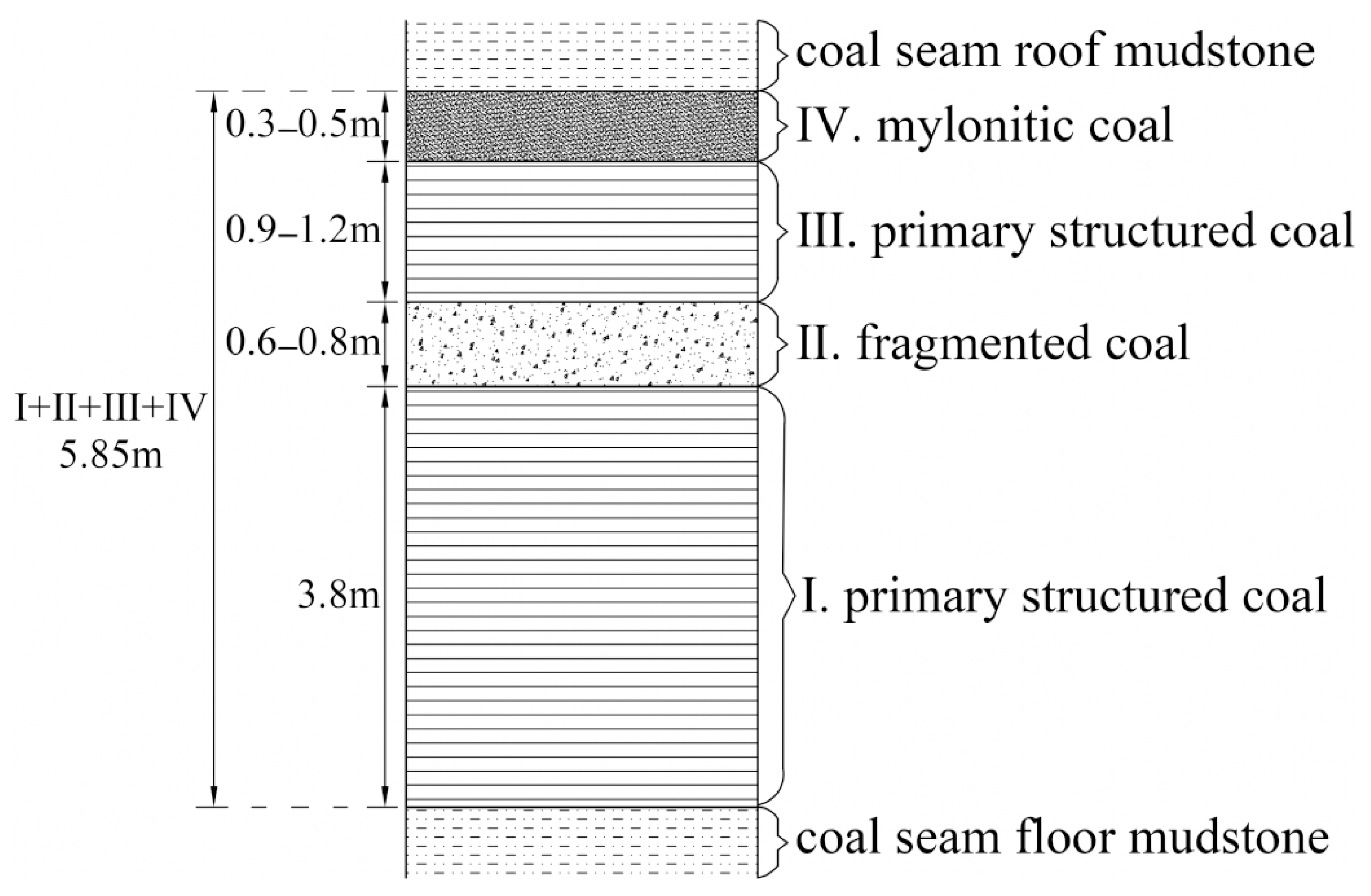
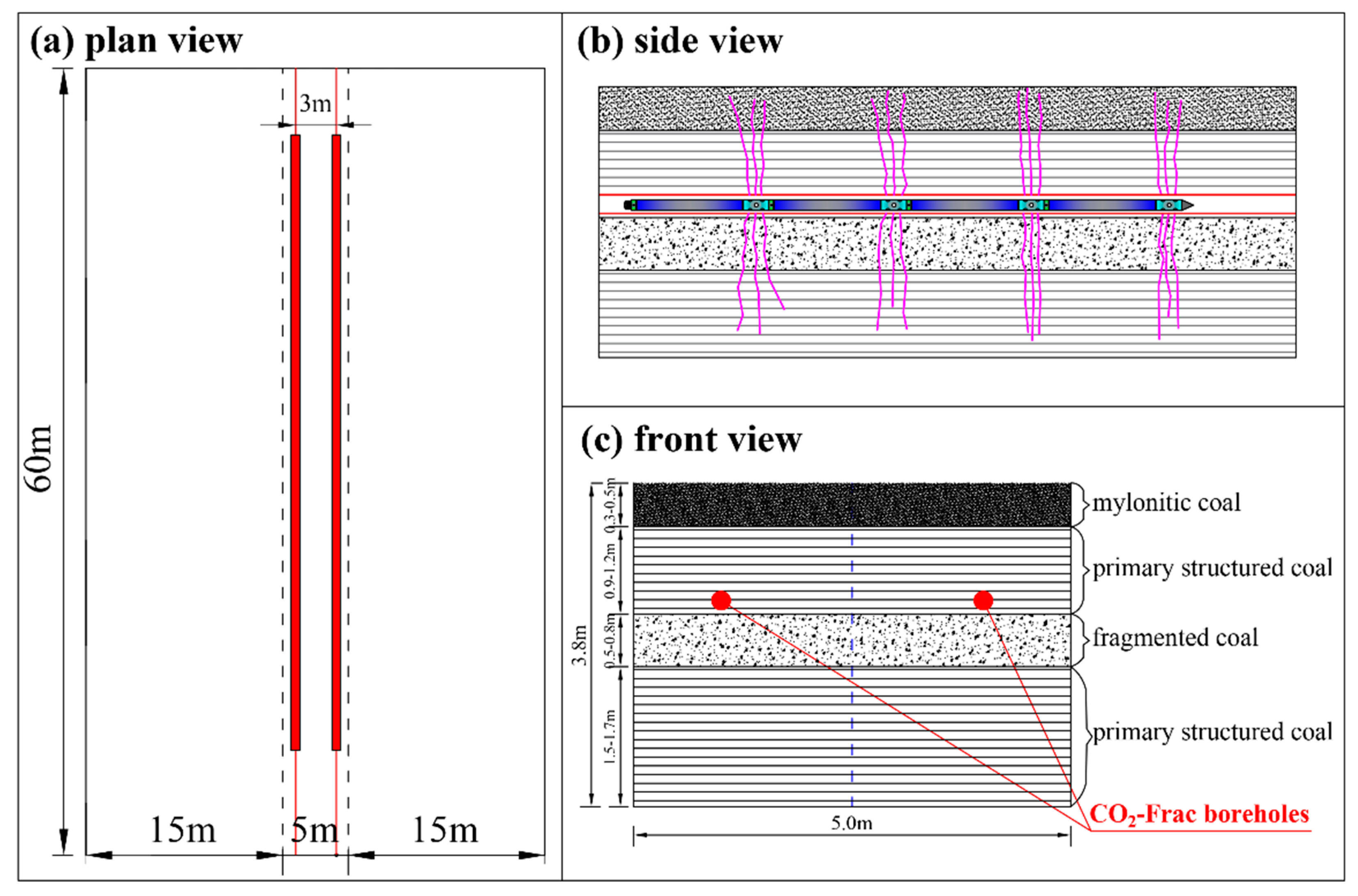
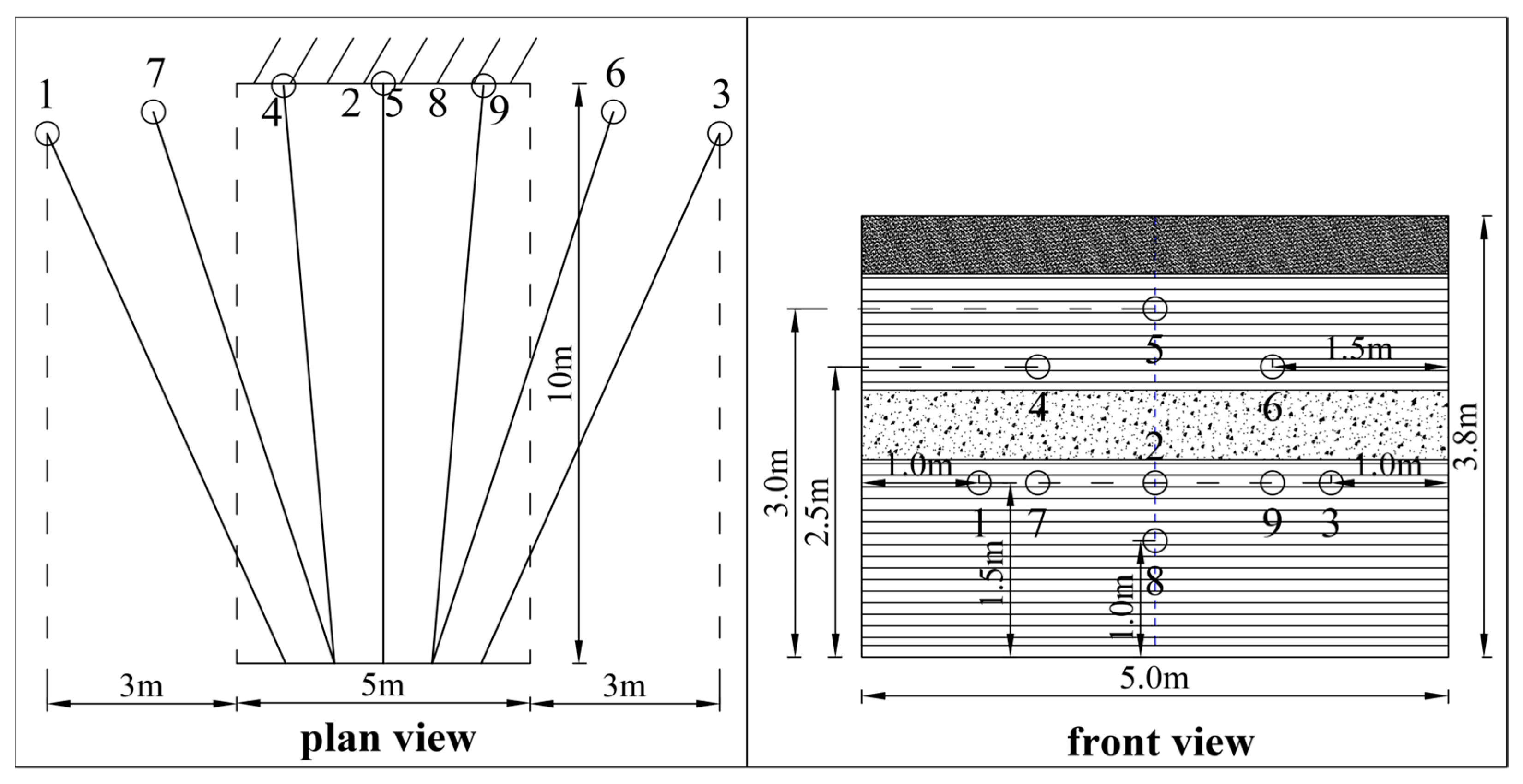
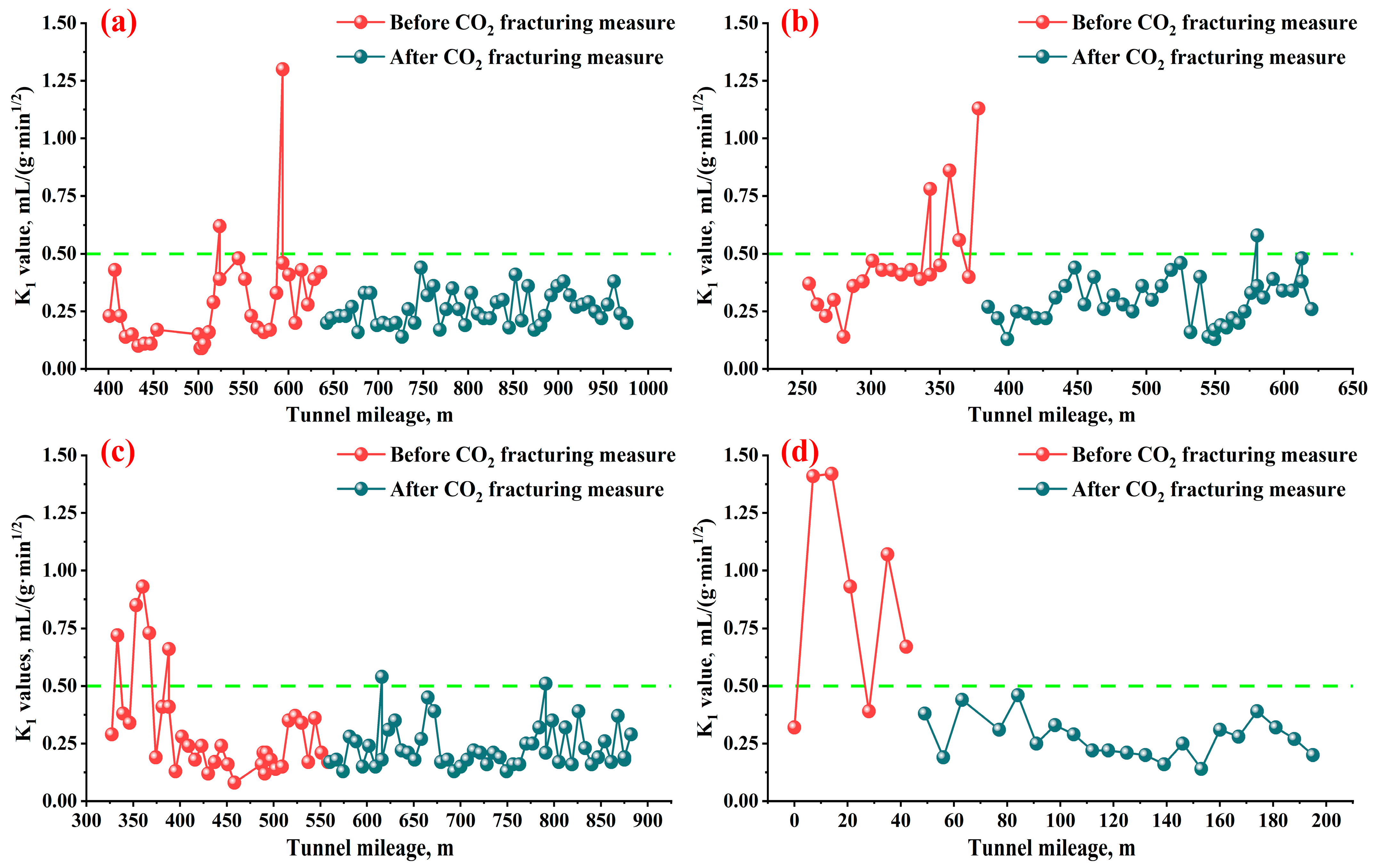




| Parameter | Reflectance | Moisture | Ash | Volatile Component |
|---|---|---|---|---|
| Romax (%) | Mad (%) | Ad (%) | Vdaf (%) | |
| Sampling Location | Initial Gas Emission Velocity ΔP/mmHg | Protodyakonov Coefficient f |
|---|---|---|
| Upper section of the coal seam in intake shaft | 25.2 | 1.03 |
| Lower section of the coal seam in intake shaft | 26.4 | 0.87 |
| Soft coal of the coal seam in intake shaft | 27.8 | 0.45 |
| Upper section of the coal seam in return air shaft | 25.7 | 1.09 |
| Middle section of the coal seam return air shaft | 26.8 | 0.74 |
| Roadway | Roadway without CO2-Frac | Roadway with High-Pressure CO2-Frac | ||||
|---|---|---|---|---|---|---|
| Footage (m) | High K1 Tests | High K1 Tests per 100 m | Footage (m) | High K1 Tests | High K1 Tests per 100 m | |
| Return airway 1 | 234.50 | 2 | 0.85 | 340.50 | 0 | 0.00 |
| Return airway 2 | 123.00 | 4 | 3.25 | 242.00 | 1 | 0.83 |
| Return airway 3 | 231.00 | 5 | 2.16 | 324.00 | 2 | 0.62 |
| Starting cut | 42.00 | 5 | 11.90 | 153.00 | 0 | 0.00 |
| Total/average | 630.50 | 16 | 2.54 | 1059.50 | 3 | 0.28 |
Disclaimer/Publisher’s Note: The statements, opinions and data contained in all publications are solely those of the individual author(s) and contributor(s) and not of MDPI and/or the editor(s). MDPI and/or the editor(s) disclaim responsibility for any injury to people or property resulting from any ideas, methods, instructions or products referred to in the content. |
© 2024 by the authors. Licensee MDPI, Basel, Switzerland. This article is an open access article distributed under the terms and conditions of the Creative Commons Attribution (CC BY) license (https://creativecommons.org/licenses/by/4.0/).
Share and Cite
Xu, Z.; Zhang, J.; Cao, Y.; Wang, Z.; Zhang, X. Study on Safety Tunneling Technology of Secondary Outburst Elimination by CO2 Gas Fracturing in High-Outburst Coal Seam. Processes 2024, 12, 1925. https://doi.org/10.3390/pr12091925
Xu Z, Zhang J, Cao Y, Wang Z, Zhang X. Study on Safety Tunneling Technology of Secondary Outburst Elimination by CO2 Gas Fracturing in High-Outburst Coal Seam. Processes. 2024; 12(9):1925. https://doi.org/10.3390/pr12091925
Chicago/Turabian StyleXu, Zongwei, Junsheng Zhang, Yunxing Cao, Zhenzhi Wang, and Xinsheng Zhang. 2024. "Study on Safety Tunneling Technology of Secondary Outburst Elimination by CO2 Gas Fracturing in High-Outburst Coal Seam" Processes 12, no. 9: 1925. https://doi.org/10.3390/pr12091925







